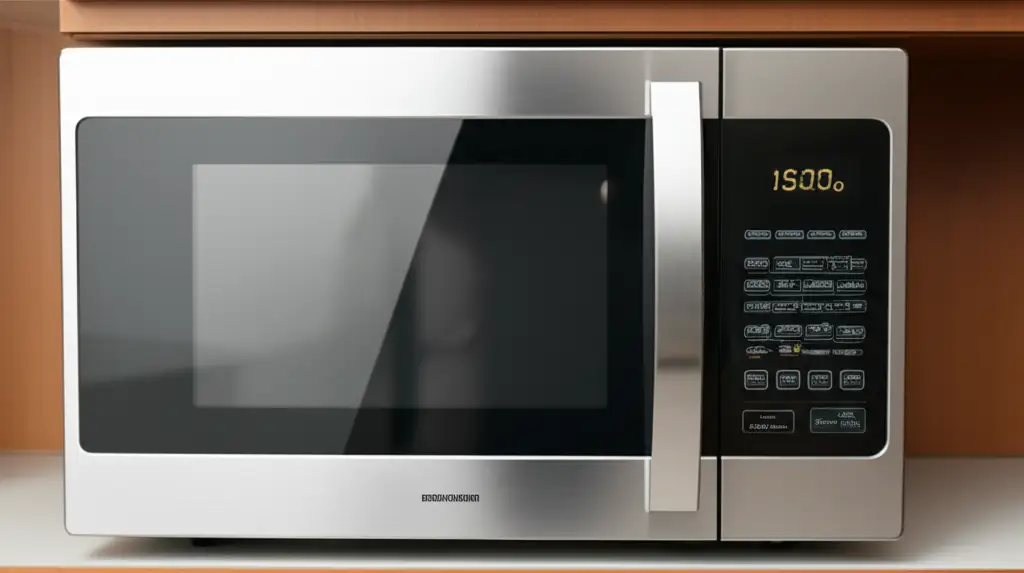· Katria Melrose · Kitchen Appliances · 19 min read
Is An Over The Range Microwave Considered Built In

Is an Over the Range Microwave Built-In? Unpacking Appliance Integration
Have you ever looked at a sleek kitchen and wondered how all the appliances seem to disappear into the design? Many homeowners want a cohesive and modern kitchen look. This often means integrating appliances seamlessly into cabinetry and countertops. A common question arises about a specific kitchen workhorse: “Is an over the range microwave considered built in?” This question is more complex than it first appears.
Understanding whether an over-the-range microwave fits the “built-in” definition can clarify your kitchen design choices. It impacts installation, functionality, and overall kitchen aesthetics. We will explore what “built-in” truly means for appliances. We will examine the unique characteristics of over-the-range microwaves. This article will help you understand their place in modern kitchen design. We will discuss their advantages and key considerations for installation. By the end, you will have a clear answer and a deeper understanding of this versatile appliance.
Takeaway:
- OTR microwaves offer a built-in aesthetic and function. They are permanently installed above your range.
- They save countertop space and include ventilation.
- Installation requires specific considerations for mounting, venting, and electrical connections.
- OTRs differ from traditional wall-mounted built-in microwaves in placement and integrated ventilation.
- They provide a clean, integrated look while adding essential kitchen functionality.
An over-the-range microwave is indeed considered a type of built-in appliance. It integrates directly into your kitchen cabinetry above the cooking range. This permanent installation frees up counter space and often includes ventilation capabilities. It differs from a freestanding countertop model or a dedicated wall-oven microwave unit.
Understanding “Built-In”: What It Truly Means
The term “built-in” for appliances suggests integration. It means the appliance is installed directly into your kitchen structure. This includes cabinets, walls, or islands. Unlike freestanding units, built-in appliances do not sit alone. They become a part of the kitchen’s architecture. This creates a flush, streamlined appearance.
This integration serves more than just looks. Built-in appliances save valuable counter space. They contribute to a more organized and efficient kitchen layout. Think of a wall oven or a dishwasher integrated behind a cabinet panel. These are classic examples of built-in appliances. Their installation requires modification of existing structures. They are not simply placed; they are fitted.
The goal of built-in appliances is to achieve a custom look. They make the kitchen appear intentional and designed. This contrasts sharply with appliances that can be moved easily. Countertop microwaves are freestanding. They sit on the counter and can be relocated. Built-in units are fixed in place. Their removal often requires effort and tools.
A built-in appliance often requires professional installation. This is due to specific electrical, plumbing, or venting needs. It ensures the appliance fits securely and safely. This level of integration sets them apart from their portable counterparts. It defines their “built-in” status.
The Essence of Appliance Integration
When we talk about appliance integration, we are talking about harmony. The appliances should blend with the kitchen’s design. This means cabinets and appliances work together. They create a unified look. For instance, some dishwashers accept custom cabinet panels. This makes them invisible within the kitchen.
Integration goes beyond just appearance. It also involves functionality. A built-in appliance is placed for optimal use within the kitchen workflow. A wall oven is at eye level for easy access. A built-in microwave might be near the cooking zone. This thoughtful placement improves kitchen efficiency. It makes cooking and cleaning easier.
Proper integration also means considering the practical aspects. This includes ventilation and electrical supply. Built-in ranges or cooktops need powerful ventilation. Built-in ovens need dedicated electrical circuits. These requirements are part of achieving true integration. They ensure safety and performance.
Ultimately, “built-in” signifies a permanent fixture. It is an appliance designed to be part of the kitchen structure. This design decision impacts both aesthetics and practicality. It elevates the kitchen from a collection of items to a unified space. This concept is central to understanding where an over-the-range microwave fits.
Over-the-Range Microwaves: A Closer Look at Their Design
Over-the-range (OTR) microwaves are unique kitchen appliances. They combine a microwave oven with an exhaust fan. This dual functionality makes them popular in many homes. They are designed to fit directly above your cooking range. This placement serves a specific purpose. It maximizes space in smaller kitchens.
OTR microwaves are typically mounted to the wall and the bottom of an upper cabinet. This secures them firmly in place. The back of the microwave often houses the fan and ducting connections. This allows it to pull smoke and odors from the stovetop below. The design integrates the appliance into a fixed position. This contributes to its built-in feel.
Manufacturers design OTR microwaves with specific dimensions. These dimensions allow them to fit standard kitchen cabinet openings above ranges. They are often wider than typical countertop microwaves. Their depth is also tailored to align with upper cabinets. This ensures a clean, flush appearance when installed correctly. You can learn more about what these appliances look like by visiting our guide on what does an over the range microwave look like.
The ventilation system in an OTR microwave is key. It typically offers multiple venting options. Some models can be ducted to the outside. This removes cooking odors and steam from your home. Others use a recirculating filter system. This cleans the air and returns it to the kitchen. This integrated ventilation is a major distinguishing feature.
Functionality and Versatility of OTR Units
The primary function of an OTR microwave is, of course, to heat food. Modern OTRs come with various power levels and cooking presets. They can handle a range of tasks, from reheating leftovers to defrosting meats. Many models also include sensor cooking. This feature automatically adjusts cooking time based on food moisture.
The integrated ventilation is equally important. When you cook, especially by frying or searing, smoke and grease fill the air. The OTR microwave’s fan pulls these contaminants away. This helps keep your kitchen air cleaner. It also prevents grease buildup on surfaces. This dual role makes OTRs highly versatile.
OTR microwaves are space-saving solutions. They eliminate the need for a separate range hood. They also free up valuable counter space. This makes them an excellent choice for smaller kitchens or open-concept living spaces. Their vertical placement uses otherwise unused space above the stove. This maximizes kitchen efficiency.
Some OTR models also include task lighting. This illuminates your stovetop below. This enhances visibility while cooking. This thoughtful design further integrates the appliance into the cooking zone. It makes the OTR microwave a multifunctional hub in your kitchen. This combination of features makes OTRs a practical choice for many homes.
The Overlap: Why OTR Microwaves Feel Built-In
Over-the-range microwaves give a strong impression of being built-in. This is due to their fixed installation and integrated appearance. They are not portable like countertop models. Once installed, they become a permanent fixture in your kitchen. This permanence is a key characteristic of built-in appliances.
They mount directly to the wall and the bottom of the cabinet above the range. This installation method ensures they are secure. It also creates a seamless look with the surrounding cabinetry. The appliance fills a specific void. It looks as if it was designed for that exact spot. This contributes to the integrated aesthetic.
OTR microwaves eliminate the need for a separate range hood. This further enhances the built-in feel. Instead of two distinct appliances, you have one unit performing both roles. This consolidation creates a cleaner line above your stove. It results in a less cluttered and more uniform kitchen appearance.
The design of OTR microwaves often aligns with other kitchen appliances. They come in standard finishes like stainless steel, black, or white. This allows them to match your existing range, refrigerator, and dishwasher. This consistency in design helps them blend in. It makes them seem part of a cohesive appliance suite.
Achieving a Seamless Kitchen Design
Many homeowners seek a clean and minimalist kitchen. OTR microwaves help achieve this goal. Their installation above the range keeps them off the countertop. This frees up precious workspace. A clear countertop makes a kitchen feel larger and more organized. This benefit is a major driver for choosing OTRs.
The direct integration with cabinetry supports this aesthetic. There are no exposed cords or irregular gaps. The microwave fits snugly into the designated space. This attention to detail creates a refined look. It makes the kitchen appear professionally designed. For a deeper dive into integrating your OTR, explore options like can an over the range microwave be installed elsewhere or how to build an over the range microwave shelf for custom solutions.
The ventilation component also plays a role in the seamless design. Because the fan is hidden within the microwave unit, it does not stand out. A separate range hood, while functional, is a distinct visual element. The OTR combines these functions. It reduces visual clutter. This contributes to the overall sleekness of the kitchen.
For those considering a fully integrated kitchen, the OTR microwave is a natural fit. It offers the appearance of a custom installation without the need for extensive carpentry. This makes it an accessible option for homeowners desiring a high-end look on a more modest budget. It provides the visual benefits of a built-in appliance with added versatility.
Key Differences: OTR vs. Dedicated Built-In Microwaves
While over-the-range (OTR) microwaves share characteristics with built-in units, they are not identical to dedicated built-in microwaves. Understanding these differences is important. It helps you choose the right appliance for your kitchen needs. Each type serves a distinct purpose and has unique installation requirements.
The most obvious difference lies in placement. An OTR microwave is always installed above the range or cooktop. It integrates a ventilation system specifically for stovetop use. A dedicated built-in microwave, however, is designed to be installed into a wall cabinet or pantry. It can be at any height you choose, often at eye level for convenience.
Dedicated built-in microwaves rarely include a ventilation system. Their primary function is just microwaving. If installed over a cooktop, a separate range hood would be necessary. This means two separate appliances for cooking and venting. The OTR unit combines both functions into one appliance.
Installation methods also differ. OTR microwaves typically mount to the cabinet above and the wall behind. They require specific clearances from the cooking surface below. Dedicated built-in microwaves often slide into a cutout. They are usually secured with trim kits. These kits create a finished, flush look. You can find more information on their placement and installation options here: can you put an over the range microwave in the wall or can over the range microwave be installed in cabinet.
Form and Functionality Variations
Dedicated built-in microwaves often have a more minimalist design. They are made to blend in completely with cabinetry. They might have a sleeker door mechanism or hidden controls. Their aesthetic goal is to disappear into the kitchen. OTR microwaves, while integrated, still feature the exhaust fan grill and often brighter stovetop lighting.
The internal capacity can also vary. Dedicated built-in microwaves come in a wider range of sizes. This includes compact models for small spaces or larger ones to match full-sized wall ovens. OTR microwaves have fairly standard widths to fit above typical 30-inch ranges. Their internal capacity is generally comparable across models.
Ventilation is a major functional distinction. OTR microwaves are designed to handle cooking fumes and grease from a stovetop. Their fans are positioned for this purpose. Dedicated built-in microwaves do not have this function. If you install one in a cabinet over a stovetop, you still need a separate range hood for proper ventilation.
Finally, consider the replacement process. Replacing an OTR microwave involves dealing with the venting system and mounting hardware. Replacing a dedicated built-in microwave may be simpler. It often means pulling the old unit out and sliding a new one in. This is true assuming the new unit fits the existing trim kit and opening. Both types offer a “built-in” look, but they achieve it through different design and functional approaches.
Installation and Integration: Making Your OTR Seamless
Installing an over-the-range microwave is a project that combines electrical, carpentry, and ventilation tasks. Proper installation is key to making your OTR microwave look and function like a true built-in appliance. It ensures safety and extends the life of the unit. The process typically involves several critical steps.
First, you must ensure you have the correct clearances. The microwave needs to be a specific height above your cooking surface. This ensures safety and proper ventilation. Manufacturers provide minimum height requirements in their manuals. Ignoring these can create fire hazards or reduce efficiency. For more details on this specific requirement, you can read our article on how high does over the range microwave need to be.
Next, secure mounting is essential. OTR microwaves are heavy. They require a sturdy mounting plate attached to the wall studs. The unit also typically bolts to the underside of the upper cabinet. This dual support system holds the microwave firmly in place. Precision in drilling and alignment is crucial for a level and secure installation. If you are replacing an existing unit, understanding how to remove built-in microwave with vent under cabinet might be helpful.
Electrical hookup is another vital step. OTR microwaves require a dedicated electrical outlet. This outlet is usually located inside the cabinet above the microwave. Ensuring the correct amperage and circuit is critical. This prevents electrical overloads and ensures safe operation. Knowing does an over the range microwave need its own circuit is essential for planning.
Mastering the Venting Process
The ventilation component is what truly distinguishes an OTR microwave. Most OTR units offer multiple venting options: ducted, ductless (recirculating), or vertical/horizontal external venting. Choosing the right option depends on your home’s existing setup. It also depends on your preference for air quality.
Ducted venting, also known as external venting, channels cooking fumes outside your home. This is the most effective method for removing odors, smoke, and moisture. It requires connecting the microwave’s exhaust port to existing ductwork or installing new ductwork through an exterior wall or roof. This type of installation makes the OTR truly integrated with your home’s ventilation system. For detailed steps, consider reviewing resources like how to install over the range microwave with vent.
Ductless, or recirculating, venting is simpler to install. It does not require external ductwork. Instead, the microwave’s fan pulls air through a charcoal filter. This filter removes odors and grease. The cleaned air then recirculates back into the kitchen. While less effective than ducted venting, it is a viable option for homes where external venting is not possible.
Regardless of the venting method, proper sealing and alignment are crucial. Leaks in ductwork reduce efficiency. Improperly seated filters compromise air quality. Taking the time to ensure all connections are secure guarantees your OTR microwave performs its dual function optimally. This meticulous approach to installation transforms a simple appliance into a seamless, built-in kitchen element.
Benefits of Choosing an Over-the-Range Microwave
Selecting an over-the-range (OTR) microwave for your kitchen offers a range of compelling benefits. These advantages often make OTR units a preferred choice for many homeowners. They combine functionality with smart design, making kitchen tasks more convenient and enjoyable.
Perhaps the most significant benefit is space saving. OTR microwaves eliminate the need for a bulky countertop microwave. They also replace a separate range hood. This frees up valuable counter space. In smaller kitchens, this can be a game-changer. It allows for more prep area or simply a less cluttered look. This optimization of space directly contributes to a more efficient kitchen.
Integrated ventilation is another major plus. OTR microwaves come with a built-in exhaust fan. This fan pulls smoke, steam, and odors directly from your stovetop. This helps maintain good air quality in your kitchen. It also reduces grease buildup on surrounding surfaces. Having the ventilation combined with the microwave is a clever design solution.
The streamlined appearance is a strong aesthetic advantage. An OTR microwave integrates neatly above your range. It creates a clean, continuous line in your cabinetry. This gives your kitchen a more polished and modern look. It helps achieve that desirable “built-in” feel without the need for extensive custom cabinetry or separate appliance cutouts.
Convenience and Practicality in Daily Use
OTR microwaves offer significant convenience in daily cooking. Their placement above the range puts the microwave at a natural height for many users. This means less bending down compared to a low wall-mounted or under-counter microwave. It makes checking on food or removing hot dishes more comfortable.
The built-in task lighting on many OTR models is also highly practical. This light illuminates your cooking surface. It enhances visibility while you are preparing meals on the stovetop. This is a simple but effective feature that improves your cooking experience. It is one less separate fixture you need to install.
For homeowners replacing an existing range hood, an OTR microwave is a straightforward upgrade. It often uses similar mounting points and electrical connections. This can simplify the replacement process. It turns two old appliances into one new, multifunctional unit. If you’re looking to swap out an old setup, our guide on how to replace over the range microwave with vent hood can be very helpful.
Finally, OTR microwaves can be a cost-effective choice. They offer two essential kitchen functions in one appliance. Buying a separate microwave and a separate range hood can sometimes be more expensive. This combined unit provides excellent value. It delivers both convenience and a built-in aesthetic, all while optimizing your kitchen space and budget.
Considerations Before Installing an OTR Microwave
While over-the-range (OTR) microwaves offer many benefits, it’s crucial to consider several factors before installation. These considerations ensure the microwave functions safely and effectively in your specific kitchen setup. Planning ahead can prevent common issues and ensure a smooth installation process.
First, always check height requirements. There is a minimum distance required between the bottom of the microwave and your cooking surface. This prevents fire hazards and ensures the microwave operates efficiently. Different stove types (electric vs. gas) might have slightly different clearance recommendations. Always consult your microwave’s installation manual for precise measurements. Our article on how far should over the range microwave be from stove provides more details.
Next, evaluate your venting options. OTR microwaves can vent externally (ducted) or internally (ductless/recirculating). Ducted venting is generally superior for removing odors and moisture. It requires existing ductwork or installing new ductwork through a wall or ceiling. Ductless systems filter and recirculate air, which is easier to install but less effective. Your home’s structure will determine which option is feasible.
Cabinet compatibility is another key point. OTR microwaves are designed to fit between standard upper kitchen cabinets, typically 30 inches wide. Ensure your existing cabinet structure is strong enough to support the microwave’s weight. You might need to add bracing if your cabinets are old or flimsy. Proper cabinet support is vital for safe mounting.
Electrical requirements are non-negotiable. OTR microwaves draw significant power. They usually need a dedicated 20-amp circuit. This prevents tripping breakers and ensures safe operation. Make sure you have a readily accessible electrical outlet within the upper cabinet space or can install one safely. Understanding does an over the range microwave need its own circuit is essential.
Planning for a Smooth Installation
Consider the type of wall material behind your range. If you have a tile backsplash, drilling through it requires specific drill bits and techniques. Improper drilling can crack tiles. Measuring carefully and using painter’s tape can help prevent damage. For tips on installing with tile, check out how to install over the range microwave with tile backsplash.
Think about future maintenance or replacement. While OTRs are built-in, they are not permanent fixtures. You will eventually need to replace them. Consider how accessible the mounting and electrical connections will be when that time comes. Planning for this can make future appliance swaps easier.
Finally, assess your DIY skill level. Installing an OTR microwave involves heavy lifting, precise measurements, and electrical work. If you are not comfortable with these tasks, hiring a professional installer is a wise investment. They ensure the job is done correctly, safely, and to code. This peace of mind is often worth the cost.
By carefully considering these factors, you can ensure a successful OTR microwave installation. This will provide you with a functional, space-saving, and aesthetically pleasing appliance for years to come. Your kitchen will benefit from its integrated design and efficient performance.
Expanding Your Microwave Placement Options
While over-the-range (OTR) microwaves are typically installed above the range, modern kitchen design offers more flexibility. Thinking outside the traditional “over-the-range” box can unlock new possibilities. This allows for even more tailored kitchen solutions. You might wonder if an OTR microwave can truly be versatile beyond its namesake.
One common question is whether an OTR microwave must be over the range. The answer is nuanced. While designed for that spot, their functionality does not strictly limit them. Some homeowners might consider alternative placements. This depends on their specific kitchen layout and needs. However, the ventilation feature is specifically optimized for stovetop fumes. If you place it elsewhere, you lose that key benefit. Learn more about this by reading does over the range microwave have to be over the range.
Another consideration is installing an OTR microwave into a wall or island. This is technically possible. However, it requires significant modification. You would need to create a custom enclosure. This enclosure must support the microwave’s weight and provide proper ventilation pathways. For wall installation, you must ensure adequate space and structural support. This often means building custom cabinetry or a dedicated shelf. You can find more details on options like can you install over the range microwave in island.
If you are aiming for a true “built-in” look in a different spot, a dedicated built-in microwave might be a better choice. These are specifically designed for cabinet integration. They often come with trim kits to provide a flush appearance. They don’t have the integrated ventilation of an OTR, making them ideal for areas not directly above a cooktop.
Creative Solutions for Microwave Integration
For those who want the OTR microwave’s power but not its traditional placement, custom solutions exist. You can build a dedicated shelf or cabinet section for it. This can be in a pantry or a less prominent area. This keeps the microwave off the counter. It still maintains a somewhat integrated look. Our guide on how to build an over the range microwave shelf offers insights into custom solutions.
You might also consider if an OTR microwave can serve as a countertop unit. While physically possible to place it on a countertop, it is not ideal. OTR units are heavy and bulky. They lack the finished feet or stable base of a countertop model. More importantly, their ventilation system is useless in this context. Their design is specifically for overhead mounting. If you are considering this, you should first read can I use over the range microwave as countertop to understand the implications.
Ultimately, expanding your microwave placement options requires careful planning. You must consider the appliance’s design, functionality, and your kitchen’s specific needs. While OTR microwaves are versatile, their core design is for above-range installation.





